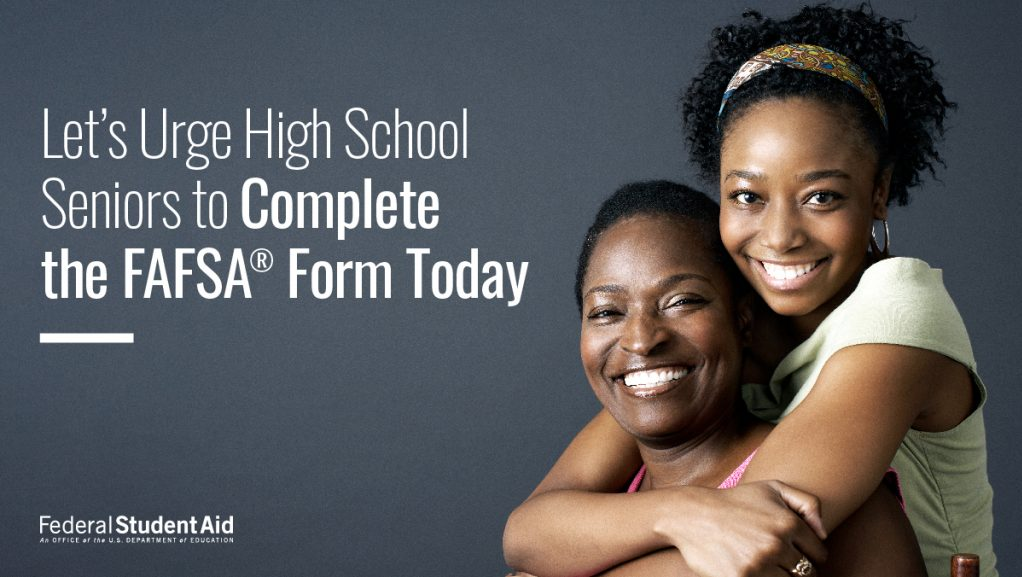By Federal Student Aid | March 25, 2021
As students and families prepare for education beyond high school, cost is a critical consideration. At Federal Student Aid, we know students and families often have to make tough decisions about higher education, and we know the COVID-19 emergency has made some of those decisions even harder.
In typical times, submitting the Free Application for Federal Student Aid (FAFSA®) form is the first step students and families should take to access federal dollars for college or career school; this is especially true during this challenging period.
In addition to federal student aid, submitting the FAFSA form also can unlock opportunities for aid from some states, postsecondary institutions, and private organizations. Because many states have limited funds, students and families should know their state’s deadline and submit the FAFSA form as early as possible.
At Federal Student Aid, we’ve seen an alarming decline in the number of high school seniors who’ve submitted the 2021–22 FAFSA form. In fact, compared to the same time last year, there’s been a 9.2% national decline in first-time FAFSA submissions by high school seniors (data as of Feb. 26, 2021). In several states—like Kentucky, Louisiana, Michigan, Mississippi, New Mexico, and West Virginia—the decline reaches double digits.
Data sources: U.S. Census Bureau, 2019 American Community Survey One-Year Estimates; U.S. Department of Education office of Federal Student Aid: 2020–21 FAFSA® Application Cycle (Oct. 1, 2019–Feb. 26, 2020) to 2021–22 FAFSA Application Cycle (Oct. 1, 2020–Feb. 26, 2021)
When we closely examine the states with the greatest declines in first-time FAFSA submissions, we find overlap with some of the states with high percentages of individuals living below the poverty level.
Higher education remains a prominent avenue for upward mobility in America. That’s why Federal Student Aid’s mission is to fund America’s future, one student at a time. By being the most-trusted source of information about federal student aid, we want to ensure all students can access higher education regardless of their ZIP code.
But today, many students across the nation are missing out on federal student aid—including critical need-based aid—by failing to submit the FAFSA form. Each year, the federal government provides more than $115 billion in federal grants, work-study funds, and loans; in award year 2018–19, about one-quarter of that aid was in the form of grants, awarded to students with financial need.
We need your help reaching students and their families. We need your help telling them that submitting the FAFSA form today—despite current uncertainties—opens up options for the future.
The U.S. Department of Education has reminded financial aid professionals that they have the authority to adjust financial aid packages based on factors, such as changes in family income. A few weeks ago, Federal Student Aid asked education leaders in all 50 states and Washington, D.C. to join us in making FAFSA completion for high school seniors a priority. And, many have responded!
For example, following a recent FAFSA completion campaign in Louisiana, FAFSA submissions increased by 5%, and education officials are making plans for a follow-up outreach campaign. Arkansas officials are partnering with Federal Student Aid, nonprofits, and for-profit organizations to develop electronic resource kits for students and families. They’re even using TikTok, the social media video-sharing platform, to engage students!
Reaching students and families where they are is why we created the myStudentAid mobile app, which is available for iOS and Android devices. The mobile app offers a convenient option for students and families to fill out and submit the FAFSA form from a cell phone or tablet. There’s a personalized dashboard, along with checklists to help students and families stay on track and the option to sign up for text alerts about important actions they need to take.
Help us spread the word to students and families to take action by filling out and submitting the 2021–22 FAFSA form today. And, please let them know there are several ways to get help if they need it when applying for federal student aid. They can
- access enhanced help topics on the FAFSA form;
- visit studentaid.gov/resources;
- use our virtual assistant, Aidan®, on StudentAid.gov or the myStudentAid mobile app;
- tweet @FAFSA; and
- speak with a customer service representative at 1-800-4-FED-AID (1-800-433-3243).
Working together, we can encourage students and families to fill out the FAFSA form today to open doors to their future.


